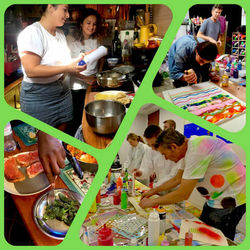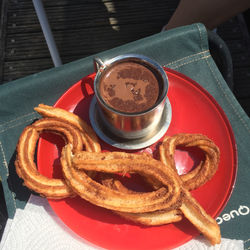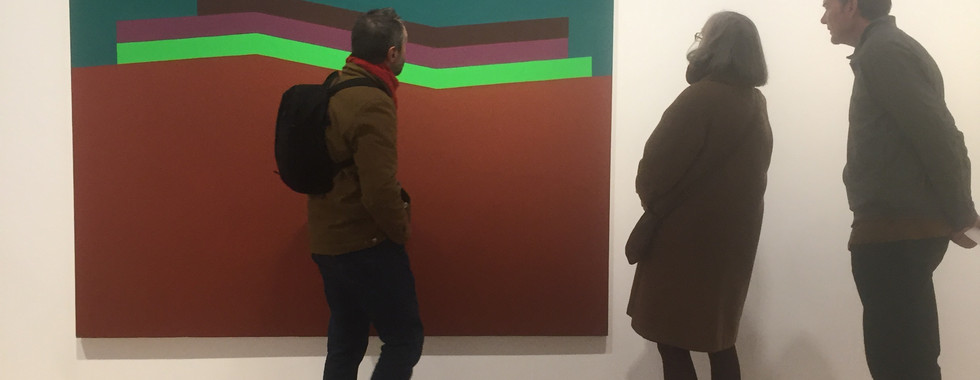How to really see art in an art gallery
- Tere

- Jun 1, 2023
- 5 min read

As a child I was always drawing and painting, it was a natural instinct that then became a talent and a passion! In my mind there was never any question that I would study art at university and I still remember vividly when I was accepted at my first choice art school, Goldsmiths College London, how happy I was!! (that's a young me on the right drawing after my art school years).
I don't know where my love of art came from and it is certainly not something we all care about or have the slightest bit of interest in, fair enough! Art has always seemed to be either a luxury or not relevant (in contemporary times). It can seem impenetrable and hostile, especially the world of contemporary art and the stylish "uber" galleries who occupy the most fashionable and expensive locations of our major cities. When I graduated from art school, I spent around 9 years working on the admin side of the art gallery business in Mayfair, London. I was thrilled to be involved in that world but I was never really part of it on many levels, other than being a creative person with a love of art. I wasn't a big fan of the pretentious side of the industry, but understood that it worked that way. I didn't come from a privileged or monied background and soon realised that the majority of employees or gallery owners were from a very different world to mine. However, I was proud that I could be an insider and an observer for those years and I certainly met some crazy people too!

So, fast forward some decades and the contemporary art gallery business is still here, and still a tough nut to crack. I like to think they are more accessible these days but I still get a shiver down my spine when I visit a museum style private gallery to see stylish and fashionable staff working at a large Apple Mac computer screen in a relatively cool and clinical atmosphere. Luckily these days, I'm just there to see the exhibitions and not to make a sale from an art collector!
Of course, art is a huge subject, there has always been some kind of art from the beginning to present day. There are many periods of art and within that many styles, movements and of course the artists themselves. So much information, where to begin?!!
Here in London we are very fortunate to have many world class public art galleries that are free to visit, like the wonderful National Gallery, Tate Britain & Modern, National Portrait Gallery, The Victoria & Albert Museum and The Wallace Collection, to name a few. These public galleries are much more accessible than the private contemporary galleries and their doors are open to anyone and everyone. There is SO much art to see and enjoy and there is no need to be an expert in painting or be an art historian to participate.
I have been giving private art tours for around 4 years in London and absolutely love it. I meet so many people from all over the world who are either wanting to see the sights or have a genuine interest in art history or contemporary art. I always take them to the National Gallery at Trafalgar Square because it really is my favourite London gallery. I remember visiting it as an art student and being in awe of the early Renaissance paintings and the Flemish masters. Since that time, I have always revisited and in recent years enrolled as a member to be able to see all the excellent exhibitions (members go free!). It is a luxury to be able to drop by and simply concentrate on one room or even one painting, each visit provides a new view point or discovery, the painting may not change but the viewer does.

I have never needed to hire a guide for a gallery tour, luckily I know my way around and like to select what I want to see and the order in which to see it, but it is always preferable to visit with a friend as I love to chat about the art whilst viewing it and of course, afterwards! On my many gallery trips I often see very large groups huddled closely around a painting, usually one of the "recommended" art works that is on their hit list, perhaps The Marriage of Arnolfini by Van Eyck or maybe The Ambassadors by Holbein, great paintings for sure but difficult to access when there are 50 people standing in front of it holding up their mobile phones!

This is why I prefer a more personal approach and my tours are strictly for very small groups, it is more enjoyable for me and for the visitor. I get the opportunity to really drill down into what we are looking at and make it a bespoke experience. I often ask my clients what they want to see or the kind of art they think may want to see and this gives me some clues as to where to concentrate my efforts.
Importantly, my tours are not heavy on history (there are plenty of other guides who do that and of course the audio guide headphones available at the galleries themselves). I much prefer to get inside the mind of the artist, why they did what they did and how did they do it? Where did they get their pigments? How were they connected to other artists of the time? What was it like to be an artist in the Renaissance period for example? I will take my guests to a particular painting and we will really look at it, ask some questions, get some opinions, discuss the colours, the composition, the technique, so much more than looking for a second then going to the next, which is the real life equivalent of flicking through a magazine or doom scrolling on your mobile!

Often, I will start my tour with looking at "traditional" art, the great masters, Renaissance and Impressionists for example. Even those with no knowledge of art can appreciate the skill of an artist who can perfectly paint a bowl of fruit or landscape with life like realism. In these cases, there is much to admire, the technical ability and vision and historically we get a visual depiction of how life was perhaps 500 years ago (no photography or social media back then!).
However, my real challenge comes when I take my guests to a gallery like Tate Modern (the most visited art gallery in the world!). Personally I like to present a comparison between historical art and the art created in our lifetime, going back at most a 100 years to present day. Not surprisingly artists have moved on from painting religious topics and wealthy patrons (well, in general) and abstract art has been around for a century now. Artists have always been resourceful and looked to for new ideas, so they have adapted readily to their times and this includes the materials available to them to create their art.

A visit to the Tate Modern collection can be a shock to those who do not appreciate or feel intimidated by non-representational art. I understand this, it is not for everyone but at least I can try to give them a perspective and allow them to see more than just a few seemingly random shapes and colours. The majority of abstract art comes from something and most artists creating this type of art have often studied figurative art and have the skills to paint a bowl of fruit or a portrait (to give an example). The point is, they have chosen not to and have experimented and developed their art in another direction.
As a trained artist I feel passionate about the perception of art in our society and why it's still there after all these centuries. Art is all around us in one form or another, not just on the walls of a beautiful museum or fashionable uber contemporary gallery. It is all about seeing and noticing and appreciating.....and that's where I come in.

Book a private art tour with me here, I can't wait to show you around!






























Comments